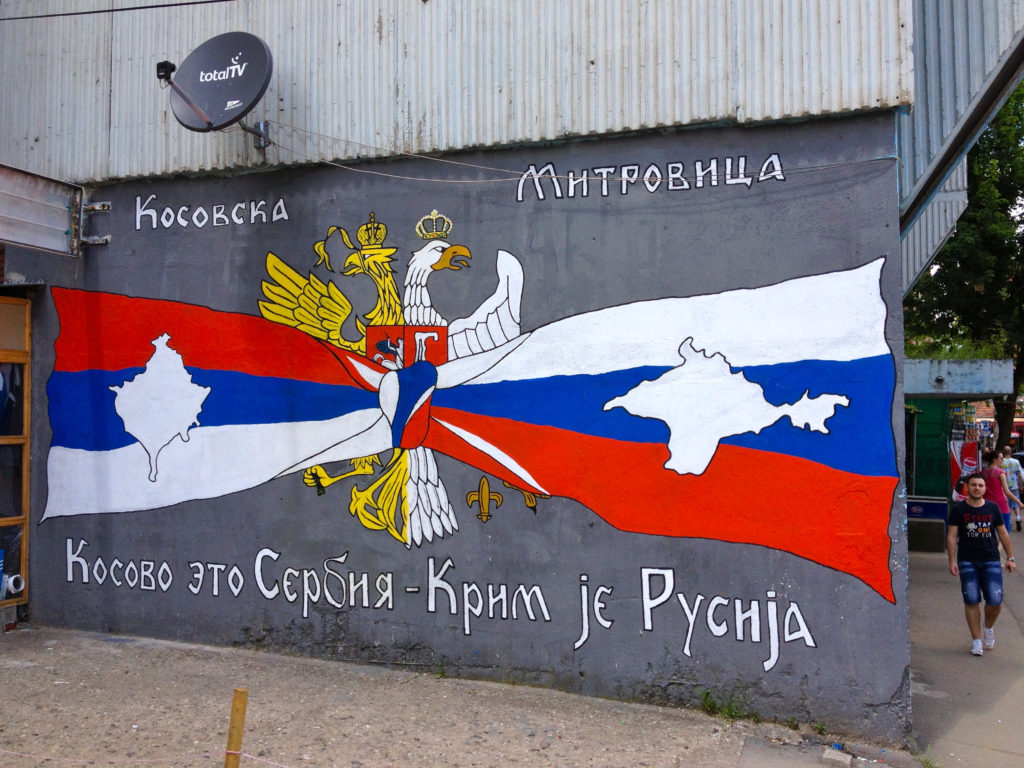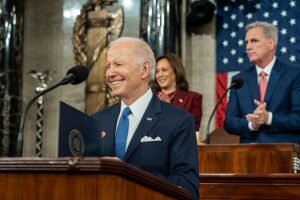Serbia and Kosovo are Pluming Their War Feathers

Photo taken in Kosovska-Mitrovica (where the train was being sent). Translated from Russian it means Kosovska Mitrovica: Kosovo is Serbian; Crimea is Russian. | Photo courtesy Allan Leonard
 Photo taken in Kosovska-Mitrovica (where the train was being sent). Translated from Russian it means Kosovska Mitrovica: Kosovo is Serbian; Crimea is Russian. | Photo courtesy Allan Leonard/CC
Photo taken in Kosovska-Mitrovica (where the train was being sent). Translated from Russian it means Kosovska Mitrovica: Kosovo is Serbian; Crimea is Russian. | Photo courtesy Allan Leonard/CC
On January 14, a passenger train bound from Belgrade, Serbia, to Mitrovica, Kosovo, nearly triggered a war. The first train to travel that route in 18 years, it was emblazoned with the red, blue and white Serbian flag and the slogan “Kosovo is Serbia” in 21 languages. The inside was decorated with Serbian Orthodox icons from the Peć monastery in Kosovo, a site of Serb ethnic heritage.
Kosovar Prime Minister Isa Mustafa condemned the train as a “provocation.” President Tomislav Nikolić of Serbia responded in kind, stating that Kosovo and Serbia “were on the verge of clashes” and that the Kosovo Albanians “want war.”
Following their bloody war at the end of the 20th century, Serbia and Kosovo failed to make any concessions. This has left them caught in a frozen conflict, chafing against one another until the blood starts flowing again.
Seemingly small incidents like the Serbian train can aggravate these already-tense relations, and conditions can deteriorate further in quick and unexpected ways. Another conflict between Kosovo and Serbia would likely draw in many other countries in Europe. It is up to the European Union to use its influence—one of the few forces capable of deescalating tensions—to rejuvenate failing normalization talks.
War broke out in Serbia and Kosovo in 1998, the last in a series of ethnic conflicts following the disintegration of Yugoslavia. When the war ended in 1999 following US-led NATO bombing of Serbia, the states were divided largely along ethnic lines with Orthodox Serbs dominating Serbia and Muslim Albanians, Kosovo. The United States and European Union remain vital to the fledgling state of Kosovo, which relies on international aid and the NATO Kosovo Force (KFOR) to keep the peace.
The EU has pressed for settling the conflict, barring both states from joining the bloc until relations are normalized. The EU-sponsored Brussels talks between Serbia and Kosovo to work towards normalization began in 2013, but nearly collapsed last month.
Yet, EU membership may not be as appealing to Serbia as it once was: the EU is facing a debt crisis in southern states, a flood of refugees, and the planned exit of Britain. The promise of economic salvation for Serbia and Kosovo seems hollow in the face of an uncertain future for the euro and the union overall. And membership for Kosovo remains an uncertain possibility, as not all EU members agree on its statehood: Spain, Slovakia, Romania, Greece and Cyprus do not recognize Kosovo’s independence.
With Serbia’s EU membership seeming less likely and less desirable, the country is moving even closer to Russia. This bodes ill for Kosovo, as the Serbs may find in Putin a sympathetic ear for reclaiming what they view as their ancestral homeland in Kosovo. Russian President Vladimir Putin has defended his own annexation of Crimea similarly, claiming it as the birthplace of Russian Orthodoxy and the Slavic state and that annexation was necessary to protect the Russian ethnic minority.
And the United States may do nothing to intervene. Serbia’s tilt toward Russia comes at a time when the US administration is increasingly Russia-friendly and is at its most isolationist in decades. President Donald Trump has vowed to pursue an “America First” foreign policy, alienated allies and has had—at best—wavering support for NATO. Some European allies fear that Trump will withdraw the 675 US troops serving in the KFOR.
US support of Kosovo and Russian support of Serbia has preserved the appearance of stability in the region, but underlying tensions remain unaddressed. As the US/Russia relationship is changing under the Trump administration, this façade may crumble entirely. A shifting power balance between Russian and US influence in the region could make war between Serbia and Kosovo all the more likely.
Serbia’s upcoming April elections raise additional concerns. With Aleksandar Vučić, the current Prime Minister and a former ultra-nationalist turned pro-EU reformer; Saša Janković, a pro-Western liberal; Vuk Jeremić, a conservative and pro-Russian former Foreign Minister; and Vojislav Šešlj, an unapologetic ultra-nationalist who has vowed to align with Russia—as candidates, the future of Serbia’s EU bid is uncertain. A Šešlj or Jeremić victory would be disastrous for the already tenuous Brussels talks.
While the train incident was a test of boundaries, Serbia is not a careless aggressor. Rather, the Western Balkans remain a tinderbox wherein each inch of progress is a challenge. Anxieties and fears are reignited by episodes such as Albanian Prime Minister Edi Rama’s statement that the unification of Albania and Kosovo is “inevitable,” and Serbia’s demand for the extradition of former Kosovar Prime Minister Ramush Haradinaj from France.
To prevent relations from deteriorating further, both parties must commit to a solution through the Brussels talks. International actors, including the US and EU, cannot shy away from their responsibilities to a region they have long directly influenced; instead, they should redouble their support for normalized relations. All of Europe would suffer for ignoring rising tensions between Serbia and Kosovo.
Stephanie Sugars is a freelance journalist and photographer, born and raised in Albuquerque, New Mexico as a shameless green chile addict, avid reader and habitual goof. She is currently pursuing a dual-degree in journalism and international relations at New York University. Stephanie writes about human rights, conflict, identity, art & literature, and transitional justice, and her work has appeared in Muftah, New York Transatlantic, Civic Ideas and Balkan Diskurs.






1 thought on “Serbia and Kosovo are Pluming Their War Feathers”